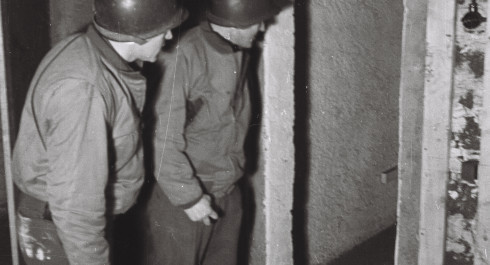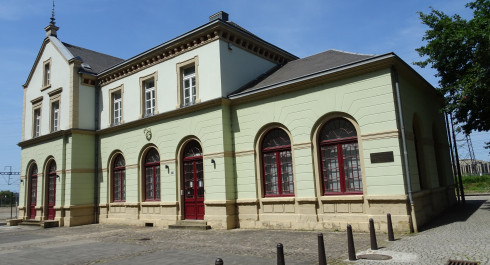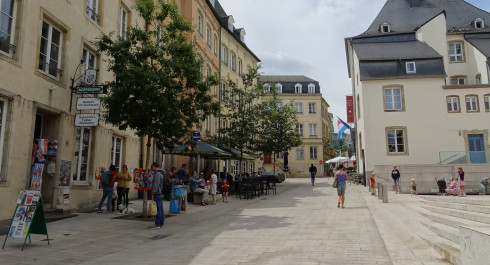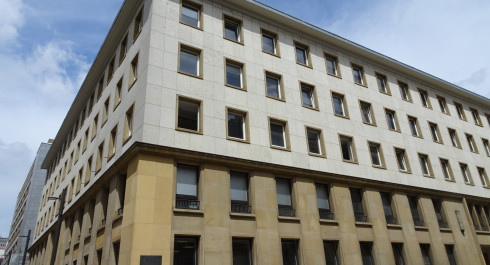
4. Villa Pauly - former Gestapo headquarters (1940-1944)
4. Villa Pauly - former Gestapo headquarters (1940-1944)
Villa Pauly was built in 1923 by the Luxembourg surgeon Dr Norbert Pauly and served as his home and medical practice. When the German troops occupied Luxembourg on 10 May 1940, Dr Pauly was on holiday in the south of France. On his return in late summer, he learned that his house had been confiscated by the Gestapo - the "Secret State Police". Reluctantly, he had to sign a lease agreement with them. In addition to their headquarters in the Villa Pauly, the Gestapo ran two field offices, one in Esch-Alzette and one in Diekirch.
Villa Pauly became the symbol of Nazi terror in Luxembourg: all those suspected of resisting National Socialism were interrogated here and often tortured. The vaults of the villa were used for those purposes. There were also some prison cells established. They were unfortunately not preserved after the war. Survivors report that they were hung upside down from heating pipes or beaten with a whip. After an initial violent interrogation, many prisoners had difficulty climbing the stairs from the cellar to the upper floors of the villa, which earned them kicks and further abuse. Around 1500 people suspected of resisting National Socialism were taken by the Gestapo to the SS concentration camp Hinzert near Trier.
The Gestapo also organised the registration and deportation of the Jewish residents at Villa Pauly. On 12 September 1940, the Chief Rabbi Dr. Serebrenik was informed that all Jewish residents of Luxembourg had to leave the country by 26 September. This order triggered a reaction of panic within the Jewish population. The Jewish consistory then asked for more time and offered its cooperation in return. At the Gestapo, the criminal police secretary Otto Schmalz was responsible for the deportation of the Jews; at the same time, he was also the contact person for the Jewish consistory. Members of the Jewish consistory had to regularly report to the Gestapo headquarters in order to receive orders regarding the organisation of the Jewish deportations. After the first deportation on 16 and 17 October 1941, Gauleiter Gustav Simon announced in the press that Luxembourg was now "free of Jews" - but in fact 6 more deportation trains left the occupied country. The solidarity and willingness of the Luxembourgers to help the Jewish population was low or almost non-existent: a handful of Jewish people were temporarily hidden within Luxembourgish families. One of the reasons for this is certainly the mainly religiously motivated anti-Semitism prevalent in this staunchly Catholic country at the time, as well as the lack of contact between the Christian and Jewish residents of Luxembourg.
Repressive measures against other minorities - such as Jehovah's Witnesses, homosexuals, Romani people, travellers and so-called "anti-social people" were also taken at the Villa Pauly.
After the war, a total of 16 members of the Gestapo in Luxembourg were sentenced for war crimes by a Luxembourgish Court. The Villa Pauly was initially rented by the Luxembourg State and used as an office for various ministries (health, labour and social affairs). In March 1960, the Luxembourg State finally became the owner of Villa Pauly and classified the building in 1989 as an historical monument. Today, Villa Pauly houses the headquarters of the Comité pour la mémoire de la Deuxième Guerre mondiale (Committee for the Remembrance of World War Two), established by law in 2016. This is an advisory body in which the three main groups of World War Two victims from Luxembourg are equally represented. For the first time since the end of the war, Jewish Holocaust victims are represented on an equal footing with the victims of anti-Nazi resistance and the victims of forced recruitment of Luxembourgers in the German armed forces. Today, the Villa Pauly also houses the headquarters of the Fondation nationale de la Résistance (FONARES) and the Fondation luxembourgeoise pour la Mémoire de la Shoah.














